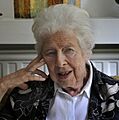Brigitte Askonas facts for kids
Quick facts for kids
Brigitte Askonas
FRS FMedSci
|
|
|---|---|
 |
|
| Born |
Brigitte Alice Askonas
1 April 1923 |
| Died | 9 January 2013 (aged 89) |
| Alma mater | McGill University (BSc, MSc) University of Cambridge (PhD) |
| Awards | Robert Koch Prize (2007) Member of the National Academy of Sciences (2007) |
| Scientific career | |
| Institutions | John Radcliffe Hospital University of Cambridge Harvard Medical School Imperial College London McGill University National Institute for Medical Research |
| Thesis | The separation of enzymes by means of organic solvents at low temperatures: application to aqueous rabbit-muscle extract with a study of creatine-phosphokinase (1952) |
| Doctoral advisor | Malcolm Dixon |
| Doctoral students | Michael J. Bevan Andrew McMichael Alain Townsend |
Brigitte Alice Askonas (born April 1, 1923 – died January 9, 2013) was a famous British scientist. She was an immunologist, which means she studied how our bodies fight off sickness. Later in her career, she was a visiting professor at Imperial College London.
Contents
Becoming a Scientist: Brigitte Askonas's Education
Brigitte Askonas was born in Vienna, Austria. Her parents were from Czechoslovakia. They had to leave Austria after the Nazis took over.
Brigitte studied biochemistry at McGill University in Canada. She earned both her bachelor's and master's degrees there. Later, she continued her studies at the University of Cambridge in England. She was a student at Girton College, Cambridge.
In Cambridge, Brigitte looked up to two amazing scientists. They were Marjory Stephenson and Dorothy Needham. These women were among the first to be chosen for the Royal Society. Brigitte learned from them that good science gets noticed, no matter who does it. She earned her PhD degree under the guidance of Malcolm Dixon.
Brigitte Askonas's Career and Research
Brigitte Askonas started her career at the Allan Memorial Institute of Psychiatry. This institute was connected to McGill University. In 1952, she joined the National Institute for Medical Research (NIMR). She became the head of the Immunology division there from 1976 to 1988.
At NIMR, she worked closely with another immunologist, John H. Humphrey. Together, they helped set up the immunology divisions. Brigitte focused on B cells. She discovered how these cells make antibodies to help our bodies fight off diseases.
Key Discoveries in Immunology
Brigitte Askonas made many important discoveries. She studied how proteins are made in milk. She found that small parts called peptides are built quickly from amino acids.
From 1955 to 1959, she used radioactivity to study how antibodies are formed. This helped us understand more about antibody molecules. It also taught us about the cells that make up our immune system.
Later, she studied plasma cell tumors. These helped her learn more about how antibodies are made. She also researched macrophages. These are special cells that show the immune system what to attack. She continued to study B cells, learning more about their role in fighting sickness.
Brigitte also wrote about other famous scientists. These included Niels Kaj Jerne and César Milstein. She even did a filmed interview with Stanley Peart. This interview is now part of a special collection at Oxford Brookes University.
Awards and Honours
Brigitte Askonas received many awards for her important work. In 2007, she became a foreign associate of the National Academy of Sciences in the United States. That same year, she won the Robert Koch Prize.
She was also elected a Fellow of the Royal Society in 1973. This is a very high honour for scientists in the UK. She also became a Fellow of the Academy of Medical Sciences.
Images for kids


